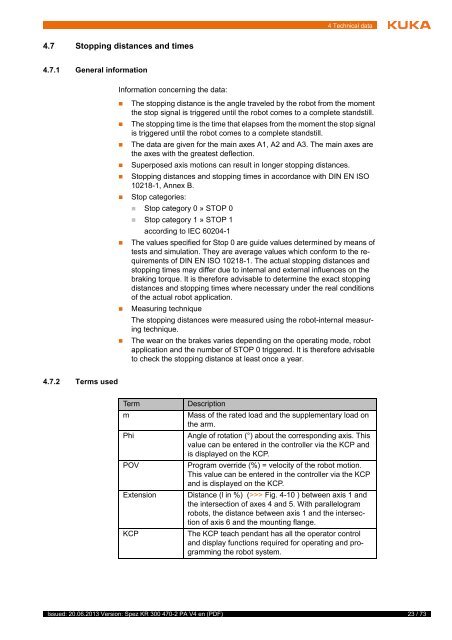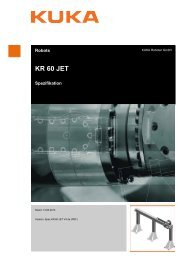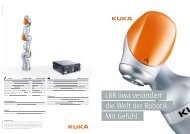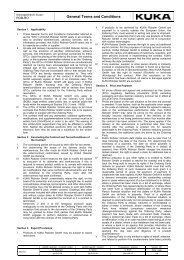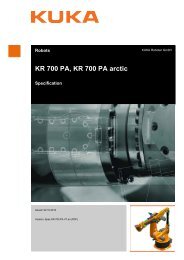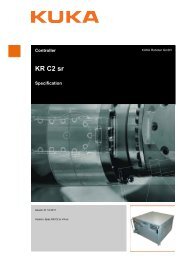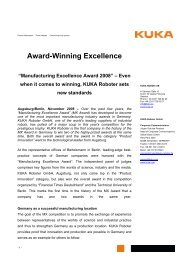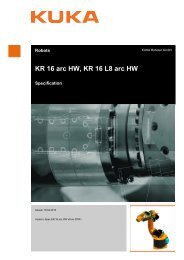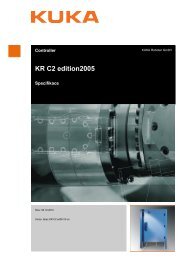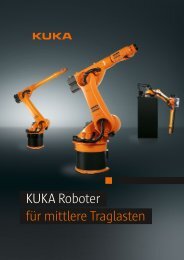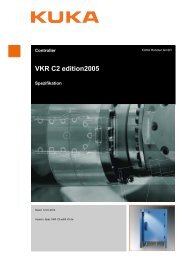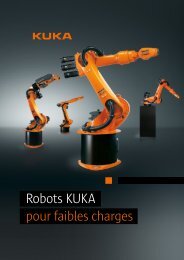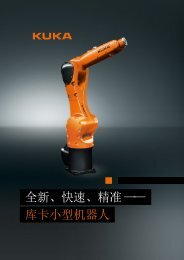KR 300-2 PA, KR 470-2 PA - KUKA Robotics
KR 300-2 PA, KR 470-2 PA - KUKA Robotics
KR 300-2 PA, KR 470-2 PA - KUKA Robotics
- No tags were found...
Create successful ePaper yourself
Turn your PDF publications into a flip-book with our unique Google optimized e-Paper software.
4 Technical data4.7 Stopping distances and times4.7.1 General informationInformation concerning the data:• The stopping distance is the angle traveled by the robot from the momentthe stop signal is triggered until the robot comes to a complete standstill.• The stopping time is the time that elapses from the moment the stop signalis triggered until the robot comes to a complete standstill.• The data are given for the main axes A1, A2 and A3. The main axes arethe axes with the greatest deflection.• Superposed axis motions can result in longer stopping distances.• Stopping distances and stopping times in accordance with DIN EN ISO10218-1, Annex B.• Stop categories:• Stop category 0 » STOP 0• Stop category 1 » STOP 1according to IEC 60204-1• The values specified for Stop 0 are guide values determined by means oftests and simulation. They are average values which conform to the requirementsof DIN EN ISO 10218-1. The actual stopping distances andstopping times may differ due to internal and external influences on thebraking torque. It is therefore advisable to determine the exact stoppingdistances and stopping times where necessary under the real conditionsof the actual robot application.• Measuring techniqueThe stopping distances were measured using the robot-internal measuringtechnique.• The wear on the brakes varies depending on the operating mode, robotapplication and the number of STOP 0 triggered. It is therefore advisableto check the stopping distance at least once a year.4.7.2 Terms usedTermmPhiPOVExtensionKCPDescriptionMass of the rated load and the supplementary load onthe arm.Angle of rotation (°) about the corresponding axis. Thisvalue can be entered in the controller via the KCP andis displayed on the KCP.Program override (%) = velocity of the robot motion.This value can be entered in the controller via the KCPand is displayed on the KCP.Distance (l in %) (>>> Fig. 4-10 ) between axis 1 andthe intersection of axes 4 and 5. With parallelogramrobots, the distance between axis 1 and the intersectionof axis 6 and the mounting flange.The KCP teach pendant has all the operator controland display functions required for operating and programmingthe robot system.Issued: 20.06.2013 Version: Spez <strong>KR</strong> <strong>300</strong> <strong>470</strong>-2 <strong>PA</strong> V4 en (PDF)23 / 73


